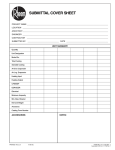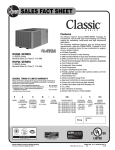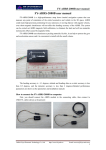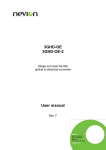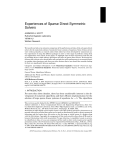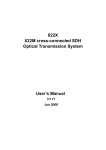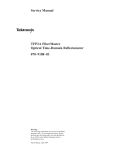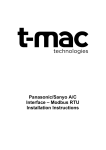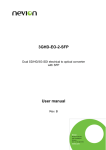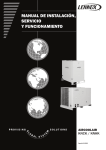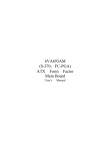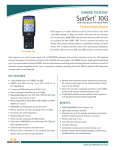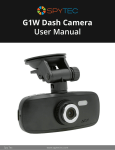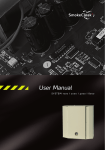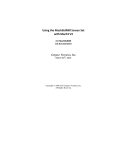Download User Manual
Transcript
Simple 21E1-155M-SDH User Manual Simple 21E1-155M-SDH Single-Board SDH Optical Transmission System V1.1 Jan. 2005 User Manual V1.1 Page 2 of 19 Contents 1. Simple 21E1-155M-SDH System Brief ------------------------------------------------------------------ 4 1.1 Outline------------------------------------------------------------------------------------------------------ 4 1.2 Product Features ---------------------------------------------------------------------------------------- 4 1.3 Technical Specifications and Standards (ITU-T series)---------------------------------------- 5 2. Equipment Interface---------------------------------------------------------------------------------------- 5 2.1 Equipment running state and alarm indicator lights -------------------------------------------- 5 2.2 Control and Auxiliary Service Interfaces ---------------------------------------------------------- 8 2.2.1 EOW (Engineer Order Wire) interface ------------------------------------------------------ 8 2.2.2 Serial network management and user channels ----------------------------------------- 9 2.2.3 Ethernet NMS interface (NMU) --------------------------------------------------------------- 9 2.3 Main service and power interfaces --------------------------------------------------------------- 10 3. Network Applications --------------------------------------------------------------------------------------- 12 3.1 Point to Point network-------------------------------------------------------------------------------- 12 3.2 Short Line network ------------------------------------------------------------------------------------ 12 4. System Installation and Operation ------------------------------------------------------------------- 12 4.1 Equipment installation-------------------------------------------------------------------------------- 12 4.1.1 Unpacking ---------------------------------------------------------------------------------------- 12 4.1.2 Equipment installation------------------------------------------------------------------------- 12 4.1.3 Electrical installation--------------------------------------------------------------------------- 13 4.1.4 Equipment grounding ------------------------------------------------------------------------- 13 4.1.5 Installation of network management system -------------------------------------------- 15 4.2 System commission ---------------------------------------------------------------------------------- 16 4.3 Network management test -------------------------------------------------------------------------- 17 4.4 E1 tributary protection switch ---------------------------------------------------------------------- 17 5. Technical Parameters -------------------------------------------------------------------------------------- 17 5.1 Mechanical dimensions------------------------------------------------------------------------------ 17 5.2 Environmental requirements ----------------------------------------------------------------------- 17 5.3 Interface features-------------------------------------------------------------------------------------- 18 5.3.1 STM-1 optical interface ----------------------------------------------------------------------- 18 5.3.2 E1 tributary interface -------------------------------------------------------------------------- 18 5.3.3 Engineer Order Wire (EOW) interface ---------------------------------------------------- 18 5.3.4 Serial NMU (RS-232) interface ------------------------------------------------------------- 19 5.3.5 Ethernet NMU (RJ-45) interface (optional) ---------------------------------------------- 19 5.3.6 Timing mode------------------------------------------------------------------------------------- 19 User Manual V1.1 Page 3 of 19 Table index Table 2-1 Simple 21E1-155M-SDH indicating lights .............................................................. 5 Table 2-2-1 EOW telephone interface.................................................................................... 8 Table 2-2-2 RS232 serial interface definition (RJ-45 end) ..................................................... 9 Table 4-2-1 Recommend measure instruments ................................................................... 17 Table 5-3-1 Technical indicators of STM-1 optical interface ................................................ 18 Table 5-3-2 E1 tributary interface......................................................................................... 18 Table 5-3-3 EOW interface .................................................................................................. 18 Table 5-3-4 Serial NMU ....................................................................................................... 19 Table 5-3-5 Ethernet NMU ................................................................................................... 19 Figure index Fig. 2-1-1 The front panel....................................................................................................... 6 Fig. 2-1-2 The indicators of the front panel ............................................................................ 7 Fig. 2-1-3 The NE address switch .......................................................................................... 7 Fig. 2-2-1-1 EOW cable ......................................................................................................... 8 Fig. 2-2-1-2 EOW card ........................................................................................................... 8 Fig. 2-2-2 Serial interface structure ........................................................................................ 9 Fig. 2-3-1 Simple 21E1-155M-SDH back panel ................................................................... 10 Fig. 2-3-2 E1 tributaries interface ......................................................................................... 10 Fig. 2-3-3 the cable for 4xE1 ................................................................................................ 11 Fig. 2-3-4 E1 cable pin-out................................................................................................... 11 Fig. 3-1 Point to Point Network............................................................................................. 12 Fig. 3-2 Simple Chain Network............................................................................................. 12 Fig. 4-1-4-1 GND Jumpers ................................................................................................... 14 Fig. 4-1-4-2 System grounding............................................................................................. 14 Fig. 4-1-5 Easy SDHTM Management system main interface ............................................... 15 User Manual V1.1 Page 4 of 19 1. Simple 21E1-155M-SDH System Brief 1.1 Outline Simple 21E1-155M-SDH is a high capacity optical transmission system based on ASICs. It provides 2x155.52Mb/s aggregate line interfaces of A and B, possessing VC-3/VC-12 non-blocking cross-connecting and channel protection function. Simple 21E1-155M-SDH is used as a terminal or an ADM in a short line (less or equal to 5 NEs); it can multiplex 21xE1 to the optical line port at most. It dose not support the ring network. The Network element management system is based on unified network management platform SDHNMS. SDHNMS is designed in accordance with related recommendations of ITU-T, so as to realize network resources, equipment configuration, alarm, performance and security management; it can support unified management of multiple optical-route non-interconnected sub-net, and support remote network monitoring by way of Internet. SDHNMS do not provides the history Alarm records and the performance records for the Simple SDH System. Table 1-1 SDH system No. Model Product Description 1 OS155S8J Simple 8E1-155M-SDH 2 OS155S16J Simple 16E1-155M-SDH 3 OS155S21J Simple 21E1-155M-SDH 4 OS155S42J Simple 42E1-155M-SDH 5 OS155S63J Simple 63E1-155M-SDH 6 OS8614 SDH optical transmission system Rack 1.2 Product Features z World leading design adopts independent ASICs, with 1U single-board structure, compactness, high reliability, low power consumption; z Provides 63 x 63 VC12 non-blocking cross-connect, supports tributaries Add/Drop of 1~21 x E1, with capability of unidirectional and bi-directional multiplexing; z Supports networks of point to point and simple chain providing functions like tributaries 1+1 channel protection; z Provides Engineer Order Wire (EOW) interface (two-line model), with dial and meeting call functions; z Supports TCP/IP for network management; z Provides F (Ethernet) and f (RS232) NMS interface; z Do not provides the historic alarm records and the performance records; z By changing the optical transceiver, it supports ultra-long distance (≤80km), long distance (≤50km) and short distance (≤30km) transmission; z Equipment adopts natural wind heat emission, with stable and reliable work. User Manual V1.1 Page 5 of 19 Supports the Free-Running timing mode, the standard G.813 timing modes are absent. z 1.3 Technical Specifications and Standards (ITU-T series) G.703 Physical/electrical characteristics of hierarchical digital interfaces. G.823 Control of jitter and wander within digital networks which are based on the 2048 kbit/s hierarchy. 2. Equipment Interface Simple 21E1-155M-SDH is a 19’‘-1U single-board design, with complete functions and compact structure, can be conveniently installed on 19’‘wide equipment rack. The equipment can meet shock, heat emission and EMC, etc. multiple national standard specifications and requirements. The front panel is arranged with various indicating lights and the control and management interfaces; while the power interfaces and the transmission interfaces are focused on the back panel of the equipment. Description of the front panel is shown in Fig. 2-1. 2.1 Equipment running state and alarm indicator lights Table 2-1 Simple 21E1-155M-SDH indicating lights Name Paraphrase Effective status Remarks PWR Equipment power-on indication Green light is on Switch disconnected/power invalid/reverse connection of polarity/blowout WORK Equipment operation indication LOS1 Optical port A signal LOSS Flashing represents a LOF LOS2 Optical port B signal LOSS Green light is flashing Red light is on Red light is on UALM Equipment urgency alarm Red light is on Flashing represents a LOF LOS ( Loss of Signal) LOF (Loss of Frame) MS_EXC (Multiplex Section Excessive Error) AU_LOP (AU Loss of Pointer) LOM (Loss of Multi-frame) HP_PLM (High Order Path Payload Mismatch) HP_TIM (High Order Path Trace Identifier Mismatch) HP_EXC (High order Path Excessive Error) TLOS (Tributary Loss) User Manual V1.1 Name DALM E1ALM BUSY Page 6 of 19 Effective status Paraphrase This end equipment appears non-urgency alarm, or alarm or performance deterioration, or branch circuit failure caused by opposite end equipment failure Red light is on Lights up when any of E1 Loss Lights up when EOW ringing Red light is on Green light is on 1. 2. 3. 4. 5. 6. 7. Remarks MS_AIS (Multiplex Section AIS) MS_RDI (Multiplex Section Remote Defect Indication) MS_DEG (Multiplex Section degraded) AU_AIS (AU AIS) HP_AIS (High Order Path AIS) HP_RDI (High Order Path Remote Defect Indication) EXCEED (High Order Error Code Overrun, including B1/B2/B3/out of limit) TU_LOP (Tributary loss of pointer) TU_AIS (Tributary AIS) LP_RDI (Low order Path channel RDI) LP_PLM (low order Path Payload Mis-match) LP_AIS (Low Order Path AIS) LP_EXCEED (Low Order Path Error Code Overrun, including BIP-2 out of limit) TAIS (Tributary input AIS) Optical port A (FC); Optical port B (FC); NE address switch; Operating state and alarm indicator lights; Management and EOW (Engineer Order Wire) interface (RJ-45); Alarm mute switch. Power switch. Fig. 2-1-1 The front panel User Manual V1.1 1. 2. 3. 4. 5. 6. 7. 8. 9. 10. 11. Page 7 of 19 PWR Operating indicator; WORK Operating indicator; LOSA Signal loss of optical port A, it also represents a LOF when flashing; LOSB Signal loss of optical port B, it also represents a LOF when flashing; UALM Urgent alarm indicator; DALM Non-urgent alarm indicator; E1ALM Signal loss of E1tributary; BUSY EOW call indicator. EOW Engineer Order Wire interface (RJ-45); RS232 NMS & User transparent serial interface (RJ-45); NMU Ethernet network management interface (RJ-45). Fig. 2-1-2 The indicators of the front panel In SDH system, for the network management, each equipment should take an inherent hardware address. The address is set by the switch manually. The coding method is simple BCD, while the address could be “00”~”99” in decimal. EXP: NE Address=01. Fig. 2-1-3 The NE address switch User Manual V1.1 Page 8 of 19 2.2 Control and Auxiliary Service Interfaces 2.2.1 EOW (Engineer Order Wire) interface Simple 21E1-155M-SDH equipment adopts standard 2-line telephone set as EOW telephone, whose cable that connected to equipment end is tailor-made: one end is RJ-11 connection telephone set; another end is RJ-45 connection Simple 21E1-155M-SDH equipment. The interface definition is as shown in the following Figure. Fig. 2-2-1-1 EOW cable Table 2-2-1 EOW telephone interface No. PIN1~3 PIN4 PIN5 PIN6~8 Definition Remarks Not connected TIP RING Not connected The EOW card is used to provide the Order Wire function. It would be installed inside Simple 21E1-155M-SDH after the client has ordered it. Fig. 2-2-1-2 EOW card User Manual V1.1 Page 9 of 19 2.2.2 Serial network management and user channels Simple 21E1-155M-SDH uses the same RJ-45 socket to lead out serial NMS (Network Management Station) and user serial interface, and uses dedicated serial interface cable: two ends are DB9 plugs; another end is RJ-45 to connect Simple 21E1-155M-SDH equipment. The cable’s linear ordering structure is as shown in the following Figure. Fig. 2-2-2 Serial interface structure Table 2-2-2 RS232 serial interface definition (RJ-45 end) No. Definition PIN1 PIN2 Data-IN Data-OUT PIN3 RSNM-LINK PIN4 PIN5 PIN6 PIN7 PIN8 GND RSNM-IN RSNM-OUT Remarks Serial data output Serial data input Serial network management connection indication Not connected Not connected Signal ground Serial network management channel input Serial network management channel output 2.2.3 Ethernet NMS interface (NMU) Apart from providing RS232 serial NMS port, it is also recommended to use Ethernet NMS port. The equipment provides NMS port on the front panel, which is used for connecting NMS. While connect to a NIC (Network Interface Card), it uses a standard UTP crossover cable (CAT-5); while connect to an Ethernet switch, it uses a straight-through cable. User Manual V1.1 Page 10 of 19 2.3 Main service and power interfaces The main service interfaces include two STM-1 optical ports and 21xE1 tributary electrical interface. J type contains only one optical port. 1. 2. 3. 4. 5. ~220VAC power interface; -48VDC power interface; 8 x E1tributary interface (#1~8); 8 x E1tributary interface (#9~16); 8 x E1tributary interface (#17~21). Fig. 2-3-1 Simple 21E1-155M-SDH back panel Simple 21E1-155M-SDH adopts 2mm high-density connector to lead out E1 tributaries from back panel; description and annotation of related E1 tributary interfaces are shown in following Figure. Fig. 2-3-2 E1 tributaries interface User Manual V1.1 Page 11 of 19 Fig. 2-3-3 the cable for 4xE1 Blue #1 E1 output Red #1 E1 input Pink #2 E1 output Brown #2 E1 input Gray #3 E1 output White #3 E1 input Yellow #4 E1 output Green #4 E1 input Fig. 2-3-4 E1 cable pin-out STM-1 optical interfaces of Simple 21E1-155M-SDH are in two groups, located at the right side of back panel; the interface is SC, the client should declare before ordering if SC is needed. Simple 21E1-155M-SDH is equipped with FC interfaces. The DC power interfaces of Simple 21E1-155M-SDH adopt three-line binding posts, used for access-48VDC and PGND (protected ground), located at the left side of the Back Panel. User Manual V1.1 Page 12 of 19 3. Network Applications 3.1 Point to Point network The default application of Simple 21E1-155M-SDH is point-to-point. Fig. 3-1 Point to Point Network 3.2 Short Line network Simple 21E1-155M-SDH supports the simple chain network which contains 5 NE at most. Fig. 3-2 Simple Chain Network 4. System Installation and Operation 4.1 Equipment installation 4.1.1 Unpacking The operator should check the completeness of equipment packaging, possible transport damage of equipment, and check correctness of equipment model and completeness of parts according to the Packing List. In case of severe defection, installation should be immediately stopped, and should contact the supplier. 4.1.2 Equipment installation Simple 21E1-155M-SDH should be installed on 19 inch standard rack. Using 4 M6×12 bolts and through 4 mounting holes at both sides of equipment front panel, fix the equipment User Manual V1.1 Page 13 of 19 on the rack. The equipment adopts natural wind cooling. In case of installation of multiple equipments, it should keep upward/downward spacing of at least 1U for the equipment. Single equipment can also keep flat on the desktop, but gapless stacking of multiple equipments is strictly forbidden. 4.1.3 Electrical installation z The power switch must be set to OFF before power on. z The supply voltage is -48VDC, -36VDC~-72VDC is tolerable. Out range voltage might result in equipment damage. Please verify the voltage before connecting. z Connect the power supply to the equipment. The reverse connection of –48VDC and GND is forbidden. It will result in the damage of internal power module. z Connect E1 cable, note the impedance matching. Within Simple 21E1-155M-SDH, it only provides 75Ω interface, the user should declare before ordering if 120Ω connection is needed. z Connect optical interface. During the BER testing of tributary, FC/SC optical jumper can be used to achieve self-loop of optical port, connect TX of port A to RX, and connect RX of port B to TX. z Connect equipment NMU interface and NMS with UTP crossover line, or connect Simple 21E1-155M-SDH serial-port to the NMS serial-port with serial cable. z Connect EOW telephone set to 21E1-155M-SDH EOW interface. z After connection of various cables, they must be fixed in cable slot with the belt, to avoid damage. z Do not overexert in plug and pull of the E1 adaptor, in avoid of pins damage. z If any fault exists, please contact the supplier. 4.1.4 Equipment grounding As compactable equipment, the “ground” is distinguished GND from PGND; when the equipment works normally, GND and PGND should be connected to the earth ground. PGND grounding resistance should be less than 4Ω, grounding cable’s profile area should be no less than 6mm2, so as to attain various electrical indicators and provide necessary conditions for safe and stable operating. Notes for the operator: 1. The Equipment case has been jointed with PGND bolt on the back panel inherently; 2. In the default factory mode, the E1 signal ground is connected to GND; if it is needed to be changed to PGND, the operator should open the equipment case and make the jumper changing manually, please see the following Fig.; 3. It is recommended for the user to connect PGND with the earth ground. User Manual V1.1 Page 14 of 19 Fig. 4-1-4-1 GND Jumpers In Simple 21E1-155M-SDH, the Earthing mode is determined by the jumper J14 and J2. In the default mode, EGNG (the signal ground of E1) is short with GND (the power ground), if it is necessary to short with PGND (the protect ground), the jumper should be changed. Recommend schematic of System Grounding: Fig. 4-1-4-2 System grounding User Manual V1.1 Page 15 of 19 4.1.5 Installation of network management system Before the operator install the SDHNMS network management system, the operator must read the user manual of SDHNMS carefully. One should set up equipment IP address (each NE should have different address) according to pre-established IP address assignment plan. Log in after the start-up of software, the default account is Administrator, password is empty. If security management is required, please enter into security management menu for account and password setting. Note: the default IP address: 192.168.2.155, one should set the address of network management PC, which should be kept within the same network segment. Fig. 4-1-5 Easy SDHTM Management system main interface User Manual V1.1 Page 16 of 19 4.2 System commission Safety Requirement Optical interface In order to ensure the personnel safety during the project contacting and using laser, following rules must be observed when operating the optical equipment: z z z z Optical fiber should be carefully kept and cleaned; and before its connection with adapter, the connector should be covered to avoid pollutions. The operator must be fully trained. Before the system power off, do not look at the connector of the optical fiber straightly. Do not bend the fiber with bending radius less than 30mm. Power interface The input power voltage of this series product is the standard industrial voltage (48V±10%) The commission can be defined as two stages: single-machine and network commission. First of all, the single-machine checking should be completed successfully. A clear network structure is required for network building, which should indicate connection relationship between the NEs, as well as the NE name, IP address list, EOW number list, E1 routing list and network clock synchronous plan. The E1 tributaries configuration of the Ethernet-bridge and the password list for the network management are also required. The operator should have the qualification of Telecom Engineer. He/she is also required to familiar with equipment maintenance, Network Construction and Network Management, as while as the security regulations. After the installation of the system (including network management system) is completed, the operator must follow these procedures: z Visual checking z Power connection checking z Optical interface measurement z Electrical interface measurement z Clock precision measurement z EOW system testing z Network management system testing z BER (bit error rate) continuous testing In order to realize test of various performance indicators, following table provides a table of recommended instruments, the operator can also choose compatible types from different vendors. User Manual V1.1 Page 17 of 19 Table 4-2-1 Recommend measure instruments Measuring instruments Types SDH analyzer Anritsu MP1570A1 SDH/PDH analyzer HP37718C Optical power meter TFC200 Variable optical pad MN9611A Multi-meter BY1935 4.3 Network management test The SDNNMS system shall be established after the software installation and the hardware connection are completed. The SDHNMS system implements the configuration of a Simple 21E1-155M-SDH, it also gives the alarms and performance records except the historic records. 4.4 E1 tributary protection switch Evaluation switch request: Alarms: LOS/LOF/LOM/AU-LOP/MS-AIS/AU-AIS/HP-AIS. Performance: MS-EXC (10-3)/MS-DEG (10-6). When the Bidirectional transmission condition is available, the system determines the switching from the failure optical port to the normal one by compare the alarm or the performance evens. All the E1 tributaries involved will be switched to the other optical port. 5. Technical Parameters 5.1 Mechanical dimensions Dimensions: 481mm (L) x 305mm (W) x 44mm (H), (contains the handle edges) Weight: 3.76Kg 5.2 Environmental requirements Power supply: -48 VDC±10% Fully equipment power consumption: 10W±10% Operating temperature: 0°C~45°C Humidity: ≤90% (free from condensing) Atmospheric pressure: 70~106 Kappa Storage temperature: -20°C ~70°C Ambient air: free from corrosive gas and soluble gas, or dust nuisance, and without strong electromagnetic field in the vicinity User Manual V1.1 Page 18 of 19 5.3 Interface features 5.3.1 STM-1 optical interface Table 5-3-1 Technical indicators of STM-1 optical interface Bit Rate 155.520Mb/s±4.6ppm Standard ITU-T G.957/G.958 Optical fiber Work wavelength Relay-free transmission range ITU-T G.652/G.653, single mode 1310nm (1550nm is optional) 50Km (70~100Km transmission distance available, the user should declare before ordering) Sensitivity Better than -36dB Connector FC (SC is optional, the user should declare before ordering) Interface S-1.1 5.3.2 E1 tributary interface Table 5-3-2 E1 tributary interface Bit Rate Encoding Standard 2.048Mb/s±50ppm HDB3 ITU-T G.703 Connector 2mm high density connector Impedance 75Ω non-balanced (120 Ω balanced is optional) Jitter performance Comply ITU-T G. 823 5.3.3 Engineer Order Wire (EOW) interface Table 5-3-3 EOW interface Bit Rate 64Kb/s Signaling mode Dual tone multi-frequency dialing mode Ring frequency 450Hz Ring mode Loudspeaker NE address range 00~99 Interface RJ-45 User Manual V1.1 Page 19 of 19 5.3.4 Serial NMU (RS-232) interface Table 5-3-4 Serial NMU Bit Rate Interface 19200b/s RJ-45 5.3.5 Ethernet NMU (RJ-45) interface (optional) Table 5-3-5 Ethernet NMU Bit Rate Mode Interface 10/100M Full/half duplex auto-negotiation RJ-45 5.3.6 Timing mode Simple 21E1-155M-SDH supports free-run timing mode.



















